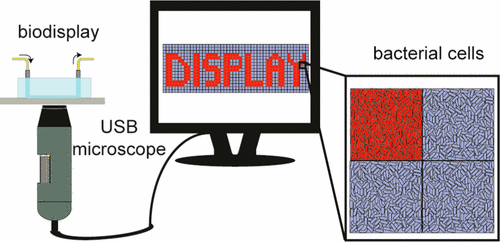当前位置:
X-MOL 学术
›
ACS Synth. Biol.
›
论文详情
Our official English website, www.x-mol.net, welcomes your
feedback! (Note: you will need to create a separate account there.)
A Microfluidic Biodisplay
ACS Synthetic Biology ( IF 3.7 ) Pub Date : 2017-08-10 00:00:00 , DOI: 10.1021/acssynbio.7b00088 Francesca Volpetti 1 , Ekaterina Petrova 1 , Sebastian J. Maerkl 1
ACS Synthetic Biology ( IF 3.7 ) Pub Date : 2017-08-10 00:00:00 , DOI: 10.1021/acssynbio.7b00088 Francesca Volpetti 1 , Ekaterina Petrova 1 , Sebastian J. Maerkl 1
Affiliation

|
Synthetically engineered cells are powerful and potentially useful biosensors, but it remains problematic to deploy such systems due to practical difficulties and biosafety concerns. To overcome these hurdles, we developed a microfluidic device that serves as an interface between an engineered cellular system, environment, and user. We created a biodisplay consisting of 768 individually programmable biopixels and demonstrated that it can perform multiplexed, continuous sampling. The biodisplay detected 10 μg/L sodium-arsenite in tap water using a research grade fluorescent microscope, and reported arsenic contamination down to 20 μg/L with an easy to interpret “skull and crossbones” symbol detectable with a low-cost USB microscope or by eye. The biodisplay was designed to prevent release of chemical or biological material to avoid environmental contamination. The microfluidic biodisplay thus provides a practical solution for the deployment and application of engineered cellular systems.
中文翻译:

微流控生物展示
合成工程细胞是功能强大且潜在有用的生物传感器,但是由于实际困难和生物安全问题,部署此类系统仍然存在问题。为了克服这些障碍,我们开发了一种微流体设备,该设备可作为工程蜂窝系统,环境和用户之间的接口。我们创建了由768个可单独编程的生物像素组成的生物显示器,并演示了它可以执行多路复用的连续采样。该生物显示器使用研究级荧光显微镜在自来水中检测到10μg/ L的亚砷酸钠,并报告砷含量低至20μg/ L,并带有易于理解的“骷髅和交叉骨”符号,可通过低成本USB显微镜或通过眼睛。生物显示器的设计旨在防止化学或生物材料的释放,以避免环境污染。因此,微流体生物显示器为工程化细胞系统的部署和应用提供了实用的解决方案。
更新日期:2017-08-10
中文翻译:

微流控生物展示
合成工程细胞是功能强大且潜在有用的生物传感器,但是由于实际困难和生物安全问题,部署此类系统仍然存在问题。为了克服这些障碍,我们开发了一种微流体设备,该设备可作为工程蜂窝系统,环境和用户之间的接口。我们创建了由768个可单独编程的生物像素组成的生物显示器,并演示了它可以执行多路复用的连续采样。该生物显示器使用研究级荧光显微镜在自来水中检测到10μg/ L的亚砷酸钠,并报告砷含量低至20μg/ L,并带有易于理解的“骷髅和交叉骨”符号,可通过低成本USB显微镜或通过眼睛。生物显示器的设计旨在防止化学或生物材料的释放,以避免环境污染。因此,微流体生物显示器为工程化细胞系统的部署和应用提供了实用的解决方案。











































 京公网安备 11010802027423号
京公网安备 11010802027423号